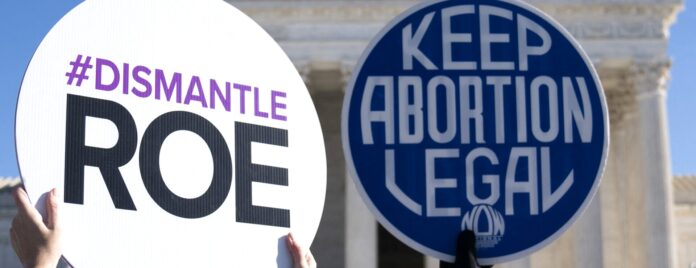Ohio voters approved a measure last week to enshrine abortion rights in the state constitution, but supporters and opponents of Issue 1 will likely be back in court soon to fight over its implementation.
The measure automatically goes into effect 30 days after passage, in this case Dec. 7. A clause in the amendment’s language says it’s “self-executing,” meaning citizens on that day will have a constitutional right to an abortion up to the point of viability outside the womb.
But both sides say the political and practical realities will likely require judges and the Republican-controlled state Supreme Court to address what exactly that looks like, and the myriad restrictions that remain on the books.
An analysis done by Attorney General Dave Yost’s (R) office last month about the potential effects of Issue 1 on current restrictions specifically mentioned laws regarding pre-viability time limits, a Down syndrome ban, bans on certain methods, and a 24-hour waiting period before obtaining the procedure as almost certainly being affected by the amendment. Others, such as requirements for ambulatory surgical centers with transfer agreements with local hospitals, may not be affected, Senate President Matt Huffman (R) told reporters Wednesday.
Officials and the legislature have signaled they’re unlikely to address the conflicts between the amendment and the laws on their own. The whole situation has put both sides in uncharted territory.
“Not since Dobbs has one been passed in a red state,” said B. Jessie Hill, a lawyer who works with abortion providers and the American Civil Liberties Union of Ohio to challenge restrictions in the state, referencing the US Supreme Court’s decision last year in Dobbs v. Jackson Women’s Health Organization. “We don’t have a lot of models to compare it to, where all the branches of government are hostile to abortion.”
Still, advocates and experts say the coming work to iron out how the measure, which passed with nearly 57% of the vote, will take effect was expected.
“Ideally, under our system, the Ohio General Assembly should recognize that Issue 1 is the law of the land in Ohio and should repeal any state statutes that conflict with it, but I am skeptical as to whether that will happen,” said Steven H. Steinglass, a former professor and dean at Cleveland State University’s law school who authored a book on the Ohio Constitution. “And I think that whether individuals affected by it will simply start acting under the law or will wait to go into court remains to be seen.”
Making the Amendment Stick
Hill, who is also a Case Western Reserve University professor and associate dean at its law school, said there are several routes to ensure the amendment trumps laws that will clearly be unconstitutional.
Those options are for the legislature to repeal conflicting laws; for officials to enter an agreement saying the laws won’t be enforced; for providers to act as if abortion is legal and perform them; and ask a court to rule that a law can’t be enforced.
Hill said the first three options likely aren’t realistic because Republicans control the state legislature and nearly all state offices. However, the last option seems to be the preferred one for providers, who tend to be risk averse, she said.
Dan Tierney, a spokesman for Gov. Mike DeWine (R), noted that the governor hasn’t endorsed any of the legislative ideas that arose in the wake of the amendment’s passage, including a proposal to take power away from judges to preside over cases about it.
Future Litigation?
While Hill didn’t divulge details about any future litigation, the general strategy is one echoed by Lauren Blauvelt, executive director of Planned Parenthood Advocates of Ohio.
“We also recognize that we are still in a super minority when it comes to the legislature,” she said during a virtual town hall Tuesday night. “So what is likely to happen is that the bans have to go through litigation.”
Tierney said DeWine, who signed a law effectively banning most abortions after six weeks of pregnancy, also expects litigation to address the conflicts between the amendment and current laws. A spokeswoman for Yost, who defends the state in court, didn’t respond to a request for comment.
The legal moves are already being put into place. The Ohio Supreme Court on Thursday ordered the state and abortion-rights forces in a case challenging the DeWine-signed ban to “address the effect on this cause, if any, of the passage of Issue 1” within three weeks. The court is deciding whether a Hamilton County Common Pleas judge’s order blocking the law should remain in place.
Multiple lawsuits over the state’s restrictions are also pending in state and federal courts.
The litigation route is distinct from what happened in Michigan after last year, when voters there passed a similar measure by nearly the exact same margin as Ohio. Michigan was in a different situation, though, with Democrats holding a majority in both chambers of its legislature when it passed bills this month repealing several restrictions on the books.
“I think there was a lot of benefit to having a legislature that was willing to enact the will of the people. In large part,” said Ashlea Phenicie, chief advocacy officer for Planned Parenthood Advocates of Michigan. She noted that “we still have some work to do.”
In Ohio, though, exactly how this will all play out is “up in the air,” Hill said. “This is sort of uncharted territory.”
(Michael Bloomberg donated $1 million to the main pro-Issue 1 group. Planned Parenthood has also received funding from Bloomberg Philanthropies, the charitable organization founded by Michael Bloomberg. Bloomberg Law is operated by entities controlled by Michael Bloomberg.)
